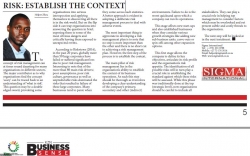Helper Zhou - Risk : Establish The Context2017-04-12 The concept of risk management can at times sound daunting for many organisations in different sectors. The major contributor as to why organisations find the concept ‘scary’ can be traced back to an understanding of ‘what is risk’. This question may be a double edged sword, provoking some organisations into serious introspection and applying themselves to discovering all there is in the risk world. But on the flip side it can trap organisations into answering the question in brief, exposing them to some of the most obvious dangers and critically leaving them exposed to unexpected events.
According to Riskviews (2016), in the past 20 years, globally more than 50 large corporates have failed or suffered significant loss due to poor risk management. Interesting to note that of the more than 80 main risk drivers; poor assumptions, poor risk culture, governance as well as unpredictable risks dominated the risks that resulted in failure of these large corporates. Many businesses tend to panic when they come across such statistics. A better approach is evident in adopting a deliberate risk management process to deal with adverse events. The most important thing to appreciate in developing a risk management plan is to note that no step is more important than the other and there is no short cut to achieving a risk management plan. However, the first step of the process is to establish the context. The main pillar of risk management lies in the organisation’s ability to establish the context of its business operations. As such this step should be thorough as it involves developing a clear understanding of the company’s primary, secondary and other (indirect) environments. Failure to do is the worst quicksand upon which a company can run its operations. This stage affects new start-ups and also established businesses when they consider various growth strategies like adding new sub business units, carve-outs or spin-offs among other expansion options. This first stage allows the company to define its key objectives, articulate its risk profile and the organisation’s risk appetite. The identification of all possible risks will in turn play a crucial role in establishing the standard against which these risks will be assessed. While this phase was traditionally done at the top (strategic level), now organisations should be careful to include all stakeholders. They can play a crucial role in helping top management to consider factors which may be overlooked and yet present subtle and costly threats to the organisation. The next step will be looked at in the next instalment. Sigma International Tel: + 2731 201 0788 Mobile: +27 73 176 5014 Email: helper@sigmaintl.co.za Web: www.sigmaintl.co.za |
Helper Zhou - Risk : Establish The Context
Copyright © 2025 KwaZulu-Natal Top Business
